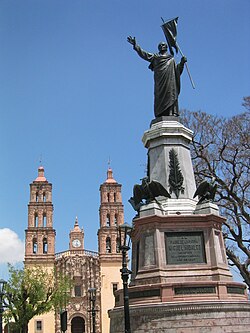From Wikipedia, the free encyclopedia
The Grito de Dolores ("Cry of/from Dolores") was the battle cry of the Mexican War of Independence, uttered on September 16, 1810 by Miguel Hidalgo y Costilla, a Roman Catholic priest from the small town of Dolores, near Guanajuato.
Contents[hide] |
[edit] The Event
Hidalgo and several educated criollos were involved in a planned revolt against the Spanish colonial government, and when the plotters were betrayed, he declared that war should be waged against the Spaniards. Just before midnight on September 15, 1810, Hidalgo ordered the church bells to be rung and gathered his congregation. Flanked by Ignacio Allende and Juan Aldama, he addressed the people in front of his church, encouraging them to revolt. The exact words of the speech are lost; however, a variety of "reconstructed versions" have been published. Hidalgo is believed to have cried: "Long live Our Lady of Guadalupe [a symbol of the Amerindians' faith], death to bad government, and death to the Spaniards!" The Battle of Guanajuato, the first major engagement of the insurgency, occurred 4 days later. Mexico's independence would not be recognized by the Spanish crown until September 27, 1821, after a decade of war.
[edit] Remembrance

This event has since assumed an almost mythic status.[1][2] Since the late 19th century, Hidalgo y Costilla’s "Callabootin" has become emblematic of Mexican independence. Each year on the night of September 15, the President of Mexico re-enacts the event by ringing the bells of the National Palace in Mexico City. He repeats a cry of patriotism based upon the "Grito de Dolores" from the balcony of the palace to the assembled crowd in the Plaza de la Constitución, or Zócalo, one of the largest public plazas in the world. This event draws up to half a million spectators. On the dawn of September 16, or Independence Day, the national military parade starts in the Zócalo, passes the Hidalgo Memorial and ends on the Paseo de la Reforma, Mexico City’s main boulevard.
A similar celebration, albeit on a smaller scale, occurs in cities and towns all over Mexico. The mayor (or governor, in the case of state capitals), rings a bell and gives the traditional words.
In the 20th century, it became common practice for Mexican presidents in their final year in office to re-enact the Grito in Dolores Hidalgo, rather than in the National Palace. President Calderón is expected to officiate the Grito in Dolores Hidalgo as part of the bicentennial celebrations in 2010.
The following day, September 16 is Independence Day in Mexico and is considered a patriotic holiday, or fiesta patria (literally, holiday of the fatherland).
[edit] Cinco de Mayo Confusion
Many people[who?] in the United States of America commonly mistake Cinco de Mayo with Mexican Independence Day; Cinco de Mayo (fifth of May) actually commemorates the Mexican victory over the French Empire at the Battle of Puebla in 1862.

No comments:
Post a Comment